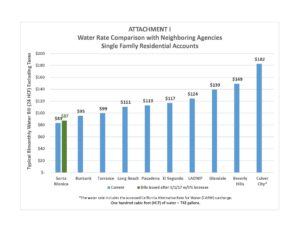BY MATTHEW HALL
Water rates will increase by five percent in 2017 resulting in an average increase of about $2 per month for the average residential user.
The increase is less than the 9 percent initially scheduled for the year and Council chose to adjust the cost at their Nov. 22 meeting after hearing revenues increased this year while costs were below expectations.
Revenues for the water fund came in at about 2.2 million higher than the budget while expenses were about $16 million below budget. The largest cost saving came from unfinished infrastructure projects and staff said the
Council previously approved five annual 9 percent rate increases in starting in 2015. While the first increase was at the full 9 percent, the 2016 increase was only 5 percent and staff said a smaller increase in 2017 would cover costs for the system.
“The recommended rate adjustment would be sufficient to allow the City to fund necessary operating and capital programs; to deliver potable water to Santa Monica customers reliably, safely and sustainably in compliance with federal and state regulations; and stay on track to achieve water self-sufficiency as planned by 2020,” said the staff report.
Gil Borboa Water Resources Manager at City of Santa Monica said money from the increase will be used to facilitate repairs to the city’s system, specifically, repair and replacement of water pipes.
Santa Monica’s pipes have a lifespan of about 100 years and the industry standard is to replace enough pipe per year to ensure the entire system is replaced within the 100-year lifespan. The rate increase will support the repair schedule while also paying for improvements and upgrades that will focus on water self-sufficiency.
Santa Monica currently imports a portion of its water from Los Angeles and local officials want to end that arrangement by 2020.
Borboa said existing and future projects are on track to meet the need provided the city can maintain the water savings it has secured during the recent shortage.
“Due to the community’s exceptional response to the mandated state drought water use restrictions and implementation of the city’s own Stage 2 water shortage response plan, the citywide water demand has dropped substantially,” he said.
According to Borboa, upgrades are needed to ensure the city not only becomes water independent, but is able to maintain that independence for the long term.
“As we work towards 2020 self-sufficiency we continue to address the longer term objective of remaining self-sufficient,” he said. “In other words, when we get to self-sufficiency by 2020, that doesn’t mean we’re done and we stop there.”
The City is exploring construction of new wells, securing expanded or new treatment facilities, expanded surveys of existing water resources and new water storage projects as tools to meet the 2020 goal.
As part of long-term planning efforts Santa Monica will be working with Beverly Hills and Los Angeles to evaluate and manage the local groundwater supply. The three municipalities are required to form a new agency under a state law that mandates better management of ground water resources. The agency will work with private well owners to understand how much water is being used for private projects, like golf courses, and to implement more stringent controls on the construction of private wells.

editor@www.smdp.com









